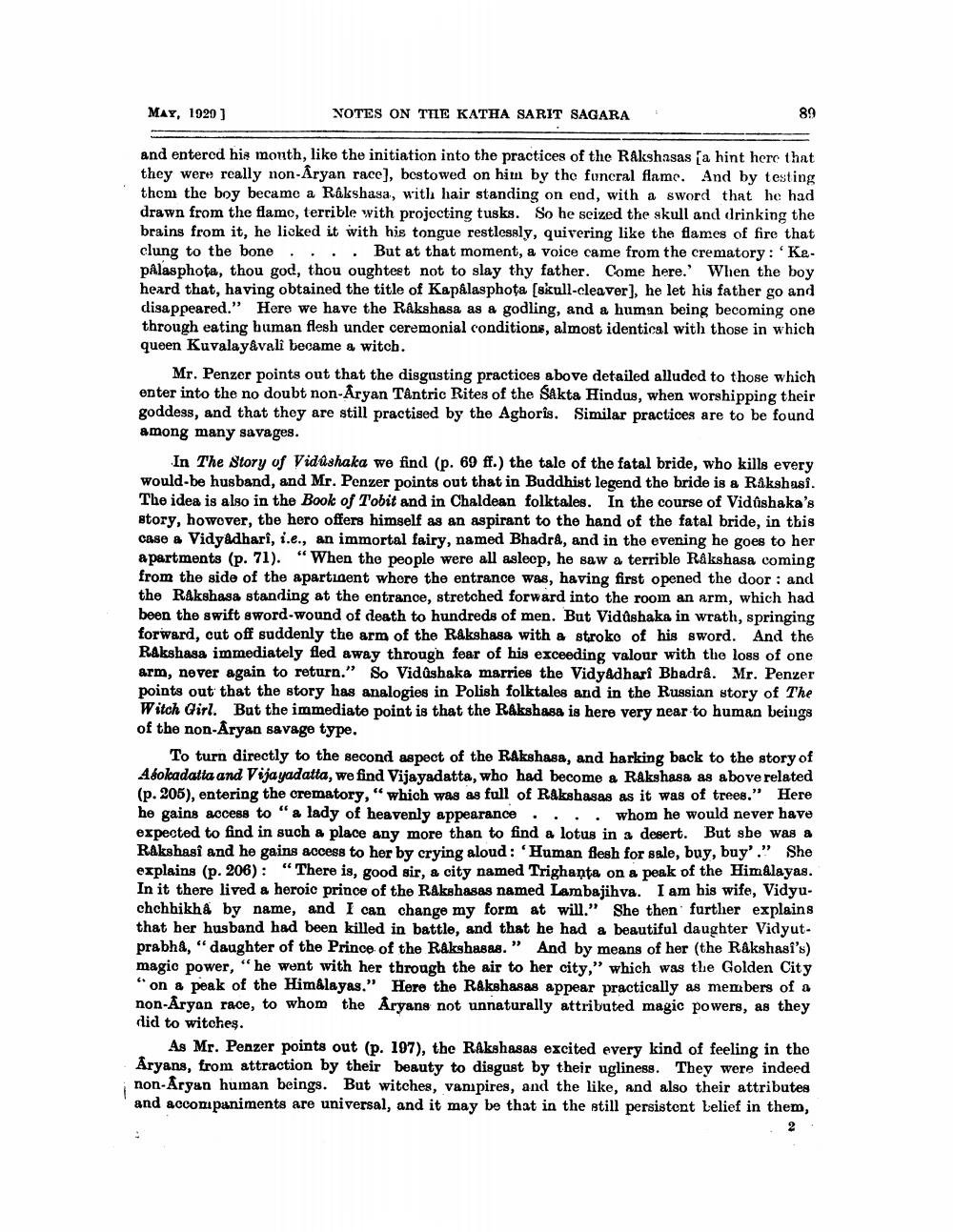________________
MAY, 1920)
VOTES ON TEIE KATHA SARIT SAGARA
89
and entered his month, like the initiation into the practices of the Rakshasas a hint here that they were really non-Aryan race), bestowed on him by the funeral flame. And by testing them the boy became a Rakshasa, with hair standing on end, with a sword that he had drawn from the flamo, terrible with projecting tusks. So he seized the skull and drinking the brains from it, he licked it with his tongue restlessly, quivering like the flames of fire that clung to the bone ....But at that moment, a voice came from the crematory: KepAlasphota, thou god, thou oughteet not to slay thy father. Come here.' When the boy heard that, having obtained the title of Kapálasphota (skull-cleaver), he let his father go and disappeared." Here we have the Rakshasa as a godling, and a human being becoming one through eating human flesh under ceremonial conditions, almost identical with those in which queen Kuvalayavalî became a witch.
Mr. Penzer points out that the disgusting practices above detailed alluded to those which enter into the no doubt non-Aryan Tantric Rites of the Sakta Hindus, when worshipping their goddess, and that they are still practised by the Aghoris. Similar practices are to be found among many savages.
In The Story of Vidushaka we find (p. 69 ff.) the tale of the fatal bride, who kills every would-be husband, and Mr. Penzer points out that in Buddhist legend the bride is a Rakshasi. The idea is also in the Book of Tobit and in Chaldean folktales. In the course of Vidůshaka's story, however, the hero offers himself as an aspirant to the hand of the fatal bride, in this case a Vidyadhari, i.e., an immortal fairy, named Bhadra, and in the evening he goes to her apartments (p. 71). “When the people were all asleep, he saw a terrible Rakshasa coming from the side of the apartment where the entrance was, having first opened the door : and the Rakshasa standing at the entrance, stretched forward into the room an arm, which had been the swift sword-wound of death to hundreds of men. But Vid shaka in wrath, springing forward, cut off suddenly the arm of the Rakshasa with a stroko of his sword. And the RAkshasa immediately fled away through fear of his exceeding valour with the loss of one arm, never again to return." So Vidûsbaka marries the VidyAdhari Bhadra. Mr. Penzer points out that the story has analogies in Polish folktales and in the Russian story of The Witch Girl. But the immediato point is that the Rakshasa is here very near to human beings of the non-Aryan savage type.
To turn directly to the second aspect of the Rakshasa, and harking back to the story of Abokadatta and Vijayadatta, we find Vijayadatta, who had become a Rakshasa as above related (p. 205), entering the crematory," which was as full of Rakshasas as it was of trees.” Here he gains access to “a lady of heavenly appearance.... whom he would never have expected to find in such a place any more than to find a lotus in a desert. But sbe was a RAkshasi and he gains access to her by crying aloud: 'Human flesh for sale, buy, buy'.” She explains (p. 206): “There is, good sir, a city named Trighanta on a peak of the Himalayas. In it there lived a heroic prince of the RAkshasas named Lambajihva. I am his wife, Vidyuchchhikh& by name, and I can change my form at will." She then further explains that her husband had been killed in battle, and that he had a beautiful daughter Vidyutprabha, "daughter of the Prince of the Rakshasas." And by means of her (the Rakshasi's) magic power, “he went with her through the air to her city," which was the Golden City "on a peak of the Himalayas." Here the Rakshasas appear practically as members of a non-Aryan race, to whom the Aryans not unnaturally attributed magic powers, as they did to witches.
As Mr. Penzer points out (p. 197), the RAkshasas excited every kind of feeling in the Aryans, from attraction by their beauty to disgust by their ugliness. They were indeed non-Aryan human beings. But witches, van pires, and the like, and also their attributes and accompaniments are universal, and it may be that in the still persistent Lelief in them,




